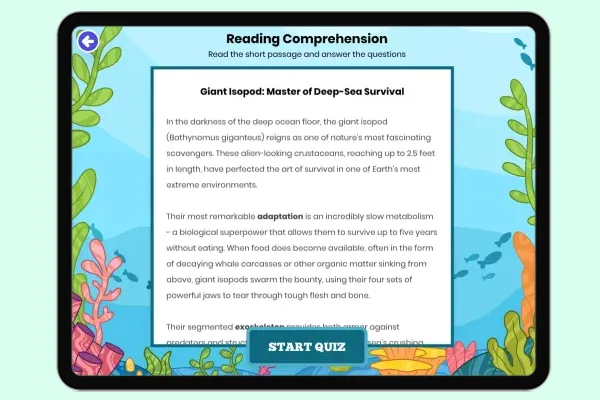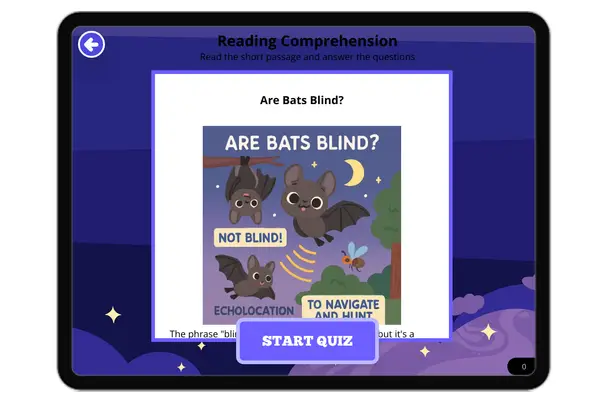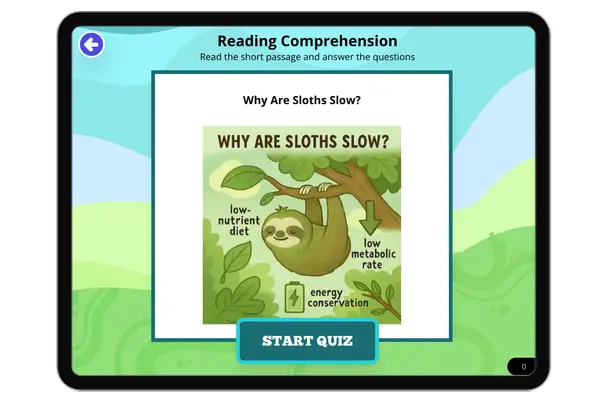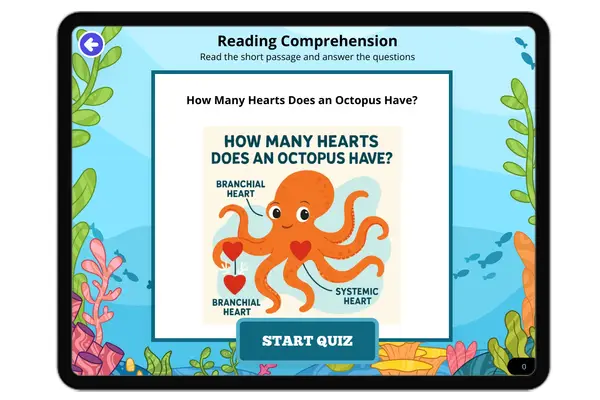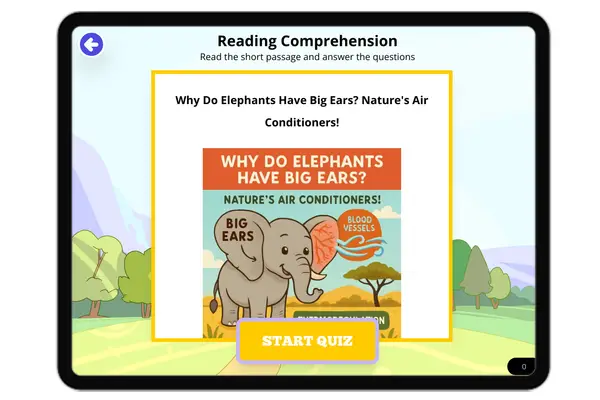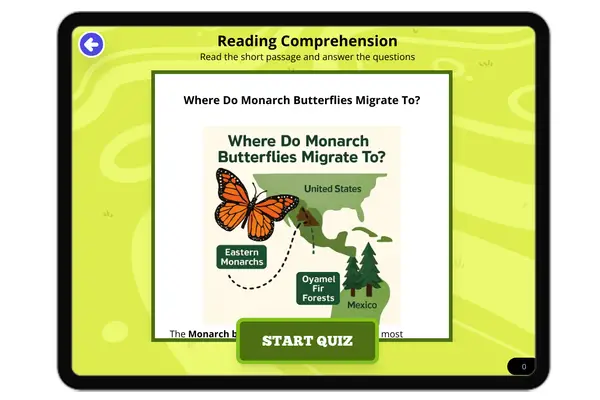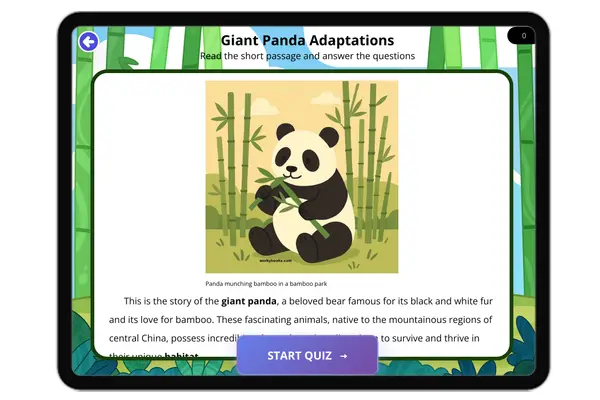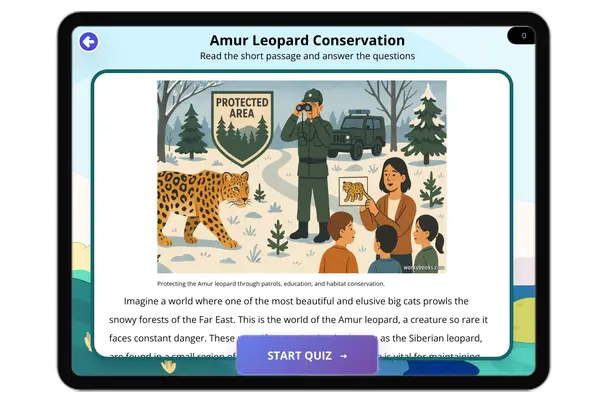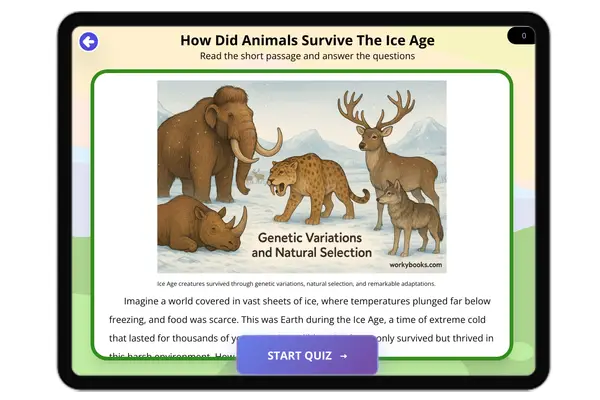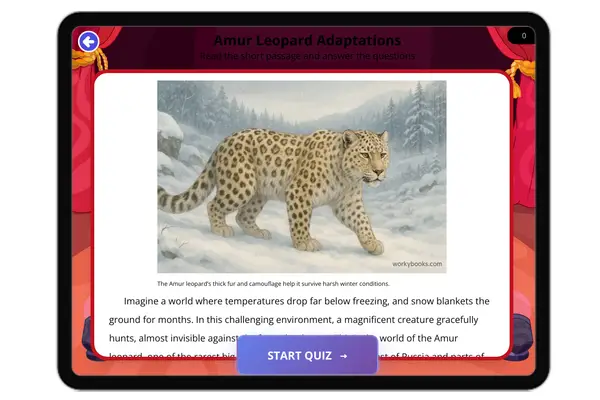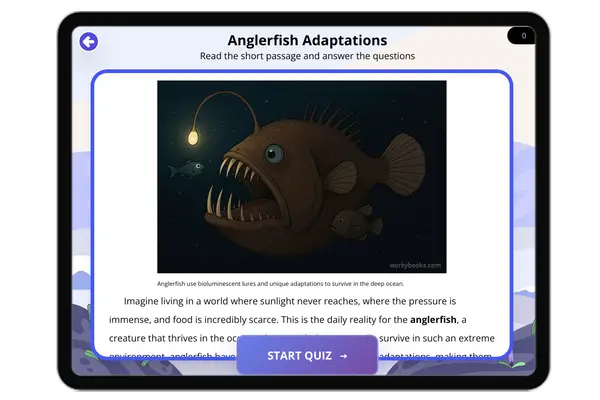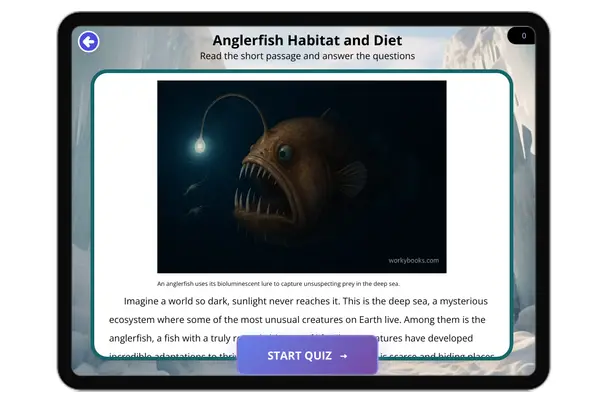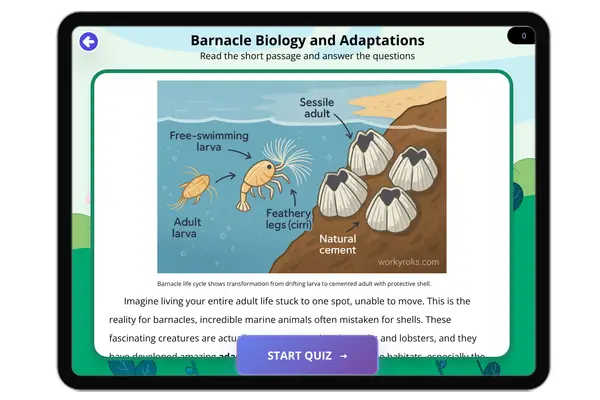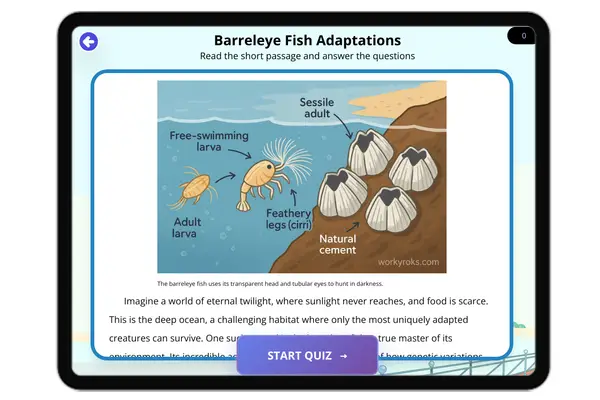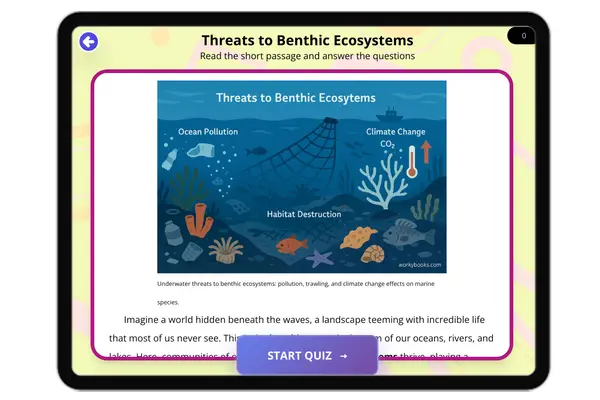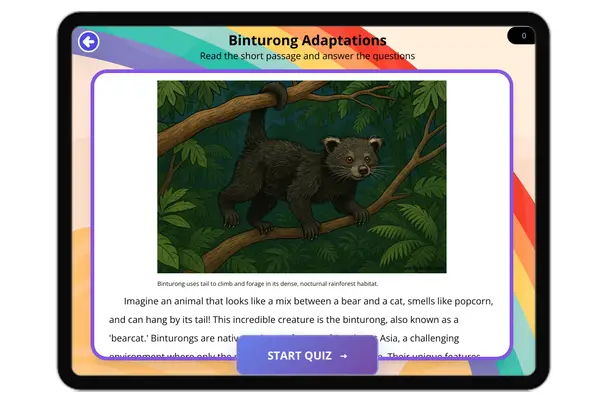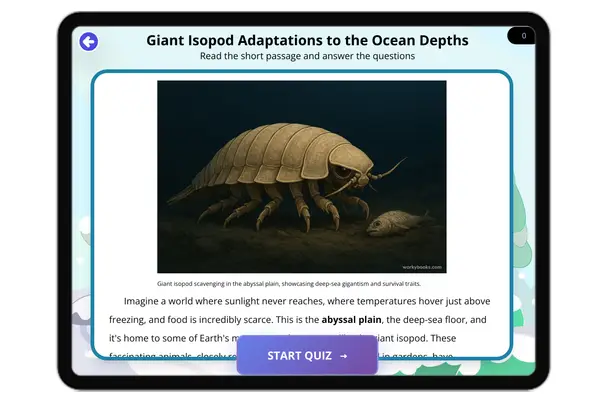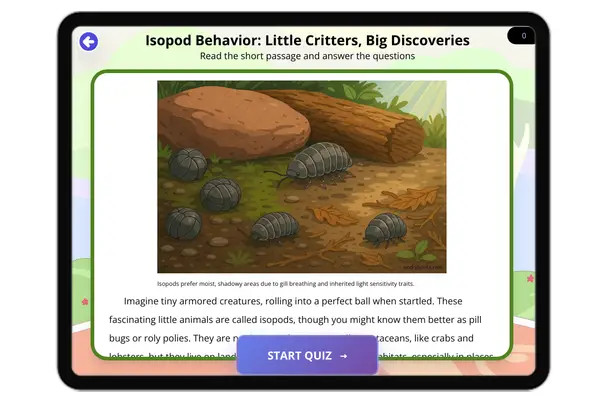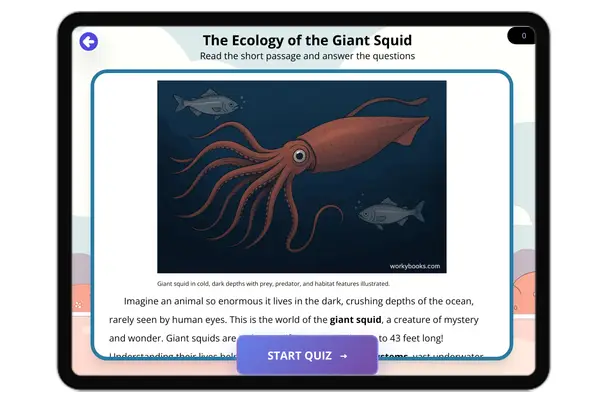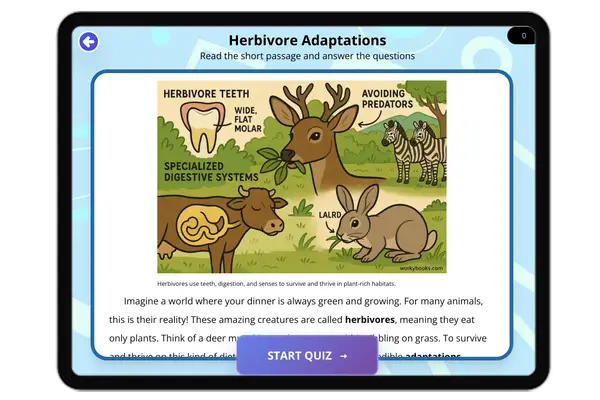The Future of the Great Barrier Reef
This passage examines potential future scenarios for the Great Barrier Reef in the face of ongoing climate change. It di...
RI.3.8RI.4.8
Beaver The Builder Animals
This passage explores NGSS K-ESS2-2 through examples of animals modifying their environment. Students learn how differen...
ESS2-2RL.1.1
How Plants and Animals Change Their World
This passage addresses NGSS K-ESS2-2 by demonstrating how plants and small animals can make significant changes to their...
ESS2-2RL.1.1
Mole's Digging
This passage addresses NGSS K-ESS2-2 by showing how moles unintentionally create beneficial environmental changes. Stude...
ESS2-2RL.1.1
Spider's Food Web
This passage supports NGSS K-ESS2-2 learning through observations of spider web construction. Students discover how smal...
ESS2-2RL.1.1
Plant Survival Word Sort
This word sort activity explores how plants survive through different features and adaptations. Students categorize 12 p...
Climate Zone Adaptations Word Sort
This word sort activity examines how plants and animals adapt to different climate conditions. Students sort 12 differen...
Animal Adaptations Word Sort
This engaging word sort activity helps students understand the difference between physical and behavioral adaptations in...
Plant Adaptations for Survival
This NGSS-aligned word sort activity, suitable for kindergarten, focuses on plant survival adaptations, helping students...
K-LS1-1
Animal Survival Features
This activity, designed for kindergarten students, aligns with NGSS K-LS1-1, 'From Molecules to Organisms: Structures an...
K-LS1-1
Animal Adaptations
This word sort activity focuses on how animals adapt to environmental changes, ideal for grade 3. Students sort words in...
Ocean Habitat Adaptations
This NGSS-aligned word sort activity focuses on how different organisms are suited for ocean life. Students sort 12 diff...
Habitat Survival Debate
Habitat Survival Debate' engages students in reasoning and categorizing organisms based on their survival potential in g...
Desert Habitat Heroes
This engaging word sort activity helps Grade 3 students understand how different organisms are adapted to survive in a d...
Who Thrives Where?
In 'Who Thrives Where?,' students classify organisms based on their ability to thrive, struggle, or fail in different ha...
Adaptations for Survival and Reproduction
This NGSS-aligned word sort activity focuses on how different variations help organisms succeed in their environment. St...
Animal Survival Traits
This engaging word sort activity helps Grade 3 students understand how variations in characteristics help species surviv...
Animal Adaptations
This NGSS-aligned word sort activity focuses on how animal traits are influenced by both genetics and environmental fact...
Plant Changes
This focused word sort activity helps Grade 3 students understand how plant traits are influenced by both inheritance an...
Survival Patterns in Animal Behaviors
In this 'Survival Patterns in Animal Behaviors' activity for 1-LS1-2, students learn how parent-offspring interactions a...
Signals and Responses in Animal Families
In the 'Signals and Responses in Animal Families' word sort activity aligned with 1-LS1-2, students explore how young an...
Dumbo Octopus: Deep-Sea Survivor with Elephant Ears
This passage aligns with NGSS standard MS-LS2-4, investigating the Dumbo octopus's unique adaptations to deep-ocean envi...
MS-LS2-4RI.6.3RI.7.3RI.8.8
The Giant Isopod: Biological Evolution
This NGSS passage examines how giant isopods evolved for deep-sea survival, including slow metabolism for food scarcity,...
MS-LS4-4RI.6.3RI.7.3RI.8.8
Barreleye Fish: The Deep-Sea Telescope
This science passage explores the barreleye fish's extraordinary adaptations aligned with NGSS standard MS-LS2-4 (Ecosys...
MS-LS2-4RI.6.3RI.7.3RI.8.8
Giant Isopod: Master of Deep-Sea Survival
This NGSS-aligned passage (MS-LS2-4) examines the giant isopod's remarkable survival strategies in deep-sea ecosystems. ...
MS-LS2-4RI.6.3RI.7.3RI.8.8
The Leafy Sea Dragon: Nature's Living Seaweed
This NGSS-aligned passage explores how leafy sea dragons (Phycodurus eques) demonstrate key life science concepts for mi...
MS-LS2-1RI.6.3RI.7.3RI.8.8
Anglerfish: The Deep-Sea Hunter with Bioluminescence
This passage aligns with NGSS standard MS-LS1-4 (Adaptations), investigating the anglerfish's extraordinary bioluminesce...
MS-LS2-4RI.6.3RI.7.3RI.8.8
How Does Cryptobiosis work
This passage explains cryptobiosis, the process where organisms like tardigrades pause their metabolism to survive extre...
MS-LS1-3RI.6.3RI.7.3RI.8.8
Snow Leopard Adaptations
Snow leopards are master survivors of harsh mountain environments. This passage explores their specialized adaptations l...
MS-LS2-CRI.6.3RI.7.3RI.8.8
Arctic Fox: Remarkable Color-Changing Adaptation
This NGSS-aligned passage (MS-LS4-4) examines the Arctic fox's remarkable seasonal color change from winter white to su...
MS-LS2-4RI.6.3RI.7.3RI.8.8
Adaptations: How Traits Help Organisms Survive
This NGSS-aligned middle school science passage explains the concept of adaptations and how they help living organisms s...
MS-LS3-1MS-LS3-2
Are Bats Blind?
This reading passage, titled "Are Bats Blind? A Myth Debunked!", directly addresses a common misconception about these f...
Why Are Sloths Slow?
This science reading passage, titled "Why Are Sloths Slow? An Energy-Saving Strategy!", explores the fascinating reasons...
How Many Hearts Does an Octopus Have?
This interactive science reading passage, titled "How Many Hearts Does an Octopus Have? A Triple Beat!", answers a commo...
Why Do Elephants Have Big Ears?
This engaging science reading passage, titled "Why Do Elephants Have Big Ears? Nature's Air Conditioners!", answers a co...
Where Do Monarch Butterflies Migrate To?
This reading passage, titled "Where Do Monarch Butterflies Migrate To? An Epic Journey!", delves into the fascinating mi...
Giant Panda Adaptations
This engaging passage delves into the fascinating world of giant pandas, exploring their unique **adaptations** that all...
Amur Leopard Conservation
This educational passage explores the critical topic of Amur leopard conservation, a fascinating and rare big cat. Stude...
How Did Animals Survive The Ice Age
This engaging passage, aligned with NGSS MS-LS4-4, delves into the fascinating world of Ice Age animals and their incred...
Amur Leopard Adaptations
This engaging, audio-integrated reading passage, 'Amur Leopard Adaptations,' is designed for Grade 6 science students. I...
Anglerfish Adaptations
This educational content package, featuring audio-integrated reading passages, dives into the fascinating world of **ang...
Anglerfish Habitat and Diet
This educational resource, with audio integration, provides a captivating reading passage about anglerfish, focusing on ...
Barnacle Biology and Adaptations
Dive into the intriguing world of barnacles with this engaging Grade 6 reading passage. Students will learn about these ...
Barreleye Fish Adaptations
This engaging, audio-integrated reading passage, 'Barreleye Fish Adaptations,' introduces students to the fascinating wo...
Threats to Benthic Ecosystems
This engaging reading passage, suitable for 6th graders and audio integrated, delves into the fascinating world of benth...
Binturong Adaptations
This engaging, audio-integrated reading passage, 'Binturong Adaptations,' for Grade 6 students delves into the fascinati...
Giant Isopod Adaptations to the Ocean Depths
Dive into the fascinating world of giant isopods and their remarkable adaptations to the ocean's depths. This engaging r...
Isopod Behavior
This engaging, audio-integrated reading passage, 'Isopod Behavior: Little Critters, Big Discoveries,' introduces Grade 6...
The Ecology of the Giant Squid
This educational passage, "The Ecology of the Giant Squid," delves into the mysterious world of one of the ocean's most ...




























